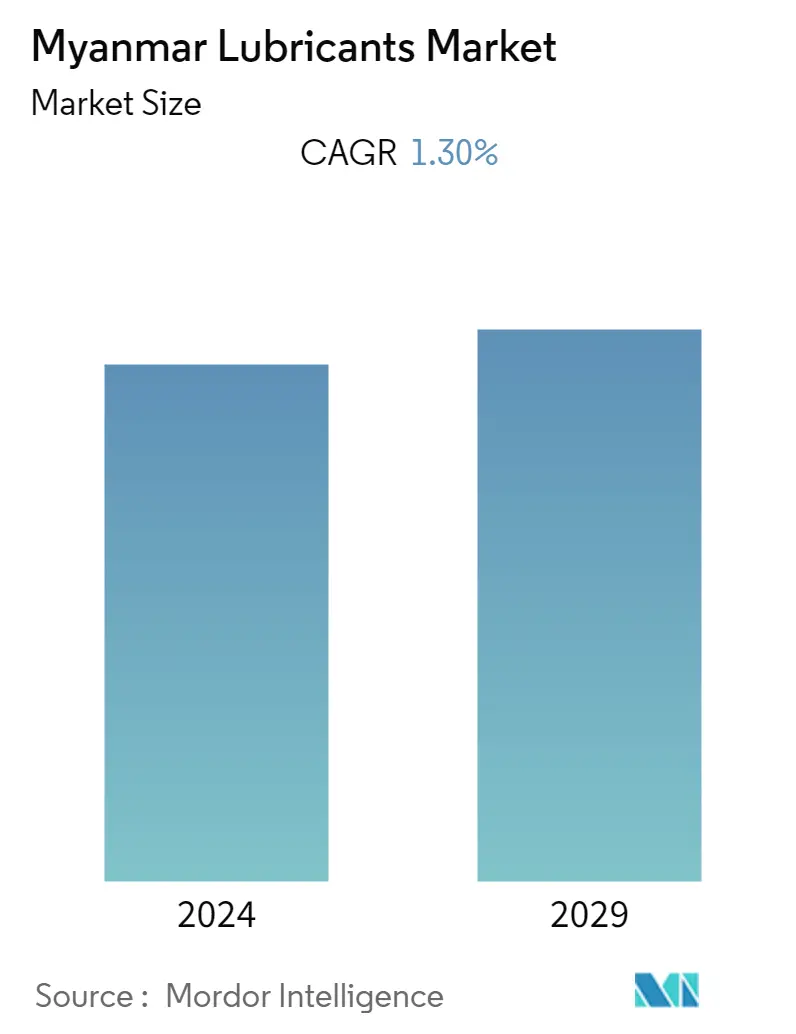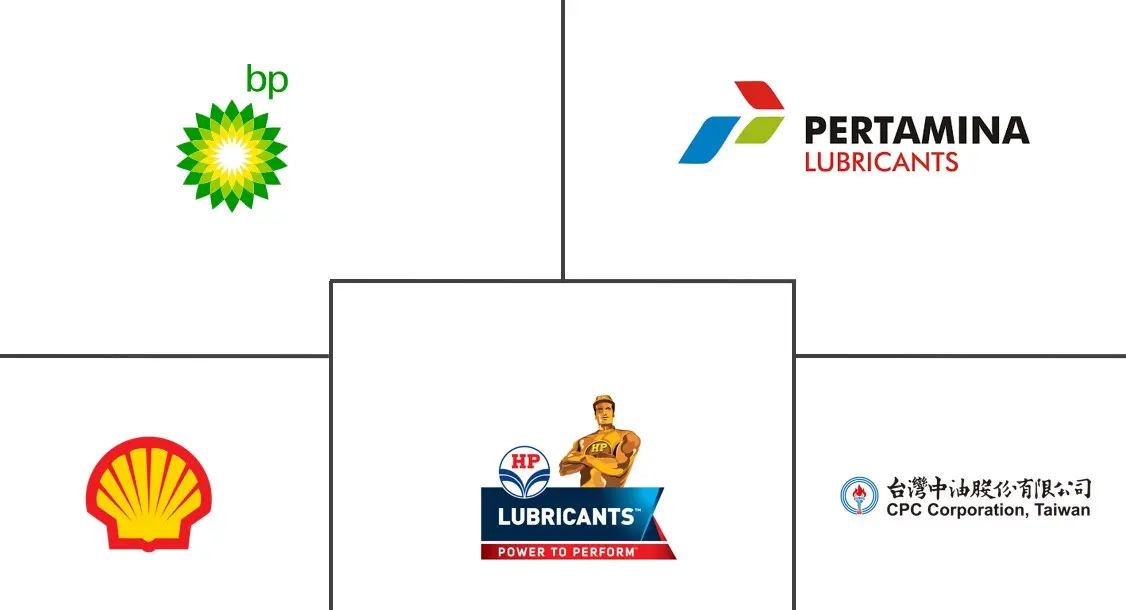Market Size of Myanmar Lubricants Industry

| Study Period | 2019 - 2029 |
| Base Year For Estimation | 2023 |
| Forecast Data Period | 2024 - 2029 |
| Historical Data Period | 2019 - 2022 |
| CAGR | 1.30 % |
| Market Concentration | High |
Major Players
*Disclaimer: Major Players sorted in no particular order |
Myanmar Lubricants Market Analysis
The Burmese lubricants market size is estimated to reach 93.73 million liters by the end of this. It is projected to reach 99.98 million liters in the next five years, registering a negative CAGR of 1.3% over the forecast period.
The COVID-19 outbreak led to a nationwide lockdown and the shutdown of manufacturing plants. It reduced the demand for lubricants from various industries, especially automotive. However, the demand substantially improved in 2021 after the restrictions were lifted.
- One of the major factors driving the market studied is the growing demand from the agriculture industry owing to the increasing usage of machinery in agriculture activities.
- On the other hand, the growing adoption of electric vehicles owing to the decarbonization goals of the country is likely to impact the market demand negatively, specifically for the engine oil segment.
- Growing research and development of synthetic and bio-based lubricants, along with the increased emphasis on sustainability, is expected to offer various opportunities for the growth of the market over the forecast period.
Myanmar Lubricants Industry Segmentation
Any substance that is physically integrated to reduce friction between two or more moving surfaces is referred to as a lubricant. On metallic surfaces, lubricants aid in preventing material degradation, erosion, corrosion, and rust development. Lubricants are typically made up of 90% petroleum-based oil and various additives to give them desirable properties specific to a given purpose.
The Burmese lubricants market is segmented by product type and end-user industry. By product type, the market is segmented into engine oils, greases, hydraulic fluids, metalworking fluids, transmission and gear oils, and other product types (process oils, circulating oils, aviation oils, etc.). By end-user industry, the market is segmented into automotive, heavy equipment, metallurgy and metalworking, power generation, and other end-user industries (food and beverage, chemical manufacturing, textile, etc.). For each segment, market sizing and forecasts have been done on the basis of volume in liters.
| Product Type | |
| Engine Oils | |
| Greases | |
| Hydraulic Fluids | |
| Metalworking Fluids | |
| Transmission and Gear Oils | |
| Other Product Types (Process Oils, Circulationg Oils, Aviation Oils, etc.) |
| End-user Industry | |
| Automotive | |
| Heavy Equipment | |
| Metallurgy and Metalworking | |
| Power Generation | |
| Other End-user Industries (Food and Beverage, Chemical Manufacturing, Textile, etc.) |
Myanmar Lubricants Market Size Summary
The Myanmar lubricants market is experiencing a complex landscape influenced by various industrial demands and economic factors. The agriculture sector is a significant driver of lubricant demand, as the increasing use of machinery in farming activities necessitates high-performance lubricants to ensure equipment reliability and efficiency. The government's focus on enhancing the agricultural sector through strategic development plans is expected to boost the demand for agricultural lubricants. These lubricants are specifically formulated to withstand harsh conditions, providing protection against oxidation, corrosion, and rust, thereby extending equipment life and reducing maintenance costs. Despite challenges such as fluctuating input prices and supply chain disruptions, the agriculture industry is poised for recovery, which will likely sustain the demand for lubricants.
Conversely, the automotive and mining industries also contribute to the lubricant market dynamics in Myanmar. The rise in automobile production and the untapped potential of the mining sector underscore the growing need for engine oils and other lubricants. The government's initiatives to attract foreign investment in mining further highlight the sector's potential, which could lead to increased demand for heavy-duty lubricants. However, the shift towards electric vehicles, driven by decarbonization goals, poses a challenge to the traditional lubricant market, particularly in the engine oil segment. The market is characterized by a few major players, including BP PLC, Shell PLC, and others, who continue to navigate these evolving trends and opportunities.
Myanmar Lubricants Market Size - Table of Contents
-
1. MARKET DYNAMICS
-
1.1 Market Drivers
-
1.1.1 Increasing Demand from Agriculture Industry
-
1.1.2 Increasing Usage of Heavy-Duty Machineries in Mining
-
1.1.3 Other Drivers
-
-
1.2 Market Restraints
-
1.2.1 Growing Penetration of Electric Vehicles
-
1.2.2 Other Restraints
-
-
1.3 Industry Value Chain Analysis
-
1.4 Porter's Five Forces Analysis
-
1.4.1 Threat of New Entrants
-
1.4.2 Bargaining Power of Buyers
-
1.4.3 Bargaining Power of Suppliers
-
1.4.4 Threat of Substitute Products
-
1.4.5 Degree of Competition
-
-
-
2. MARKET SEGMENTATION (Market Size in Volume)
-
2.1 Product Type
-
2.1.1 Engine Oils
-
2.1.2 Greases
-
2.1.3 Hydraulic Fluids
-
2.1.4 Metalworking Fluids
-
2.1.5 Transmission and Gear Oils
-
2.1.6 Other Product Types (Process Oils, Circulationg Oils, Aviation Oils, etc.)
-
-
2.2 End-user Industry
-
2.2.1 Automotive
-
2.2.2 Heavy Equipment
-
2.2.3 Metallurgy and Metalworking
-
2.2.4 Power Generation
-
2.2.5 Other End-user Industries (Food and Beverage, Chemical Manufacturing, Textile, etc.)
-
-
Myanmar Lubricants Market Size FAQs
What is the current Myanmar Lubricants Market size?
The Myanmar Lubricants Market is projected to register a CAGR of 1.30% during the forecast period (2024-2029)
Who are the key players in Myanmar Lubricants Market?
BP p.l.c., Shell Plc, HP Lubricants, PT Pertamina Lubricants and CPC Corporation are the major companies operating in the Myanmar Lubricants Market.

